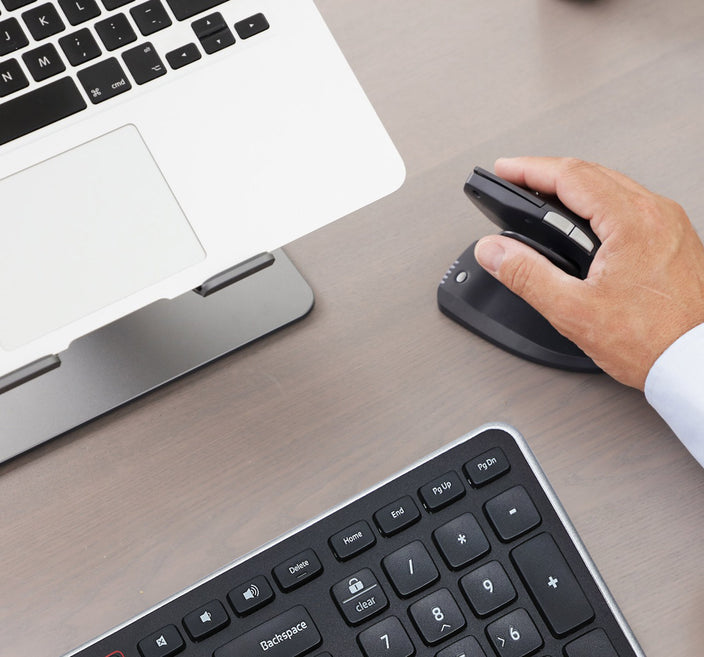When you have employees working from home, you may think you have successfully outsourced some of the responsibilities to ensure a good work environment and data protection. However, in most cases, home office rules and regulations are pretty similar to those concerning the office.
As an employer, your responsibilities for the health and safety of your workers remain the same as for any worker. This applies to those who consistently work from home long-term and those who have a hybrid workplace, shifting between the office and home.
This means that your employee's workstation at home must be just as well-equipped to ensure that they can work safely and effectively. However, employers and employees share a joint responsibility to ensure that working from home runs smoothly. As such, employers must always:
- Be open to conversations on hybrid working arrangements
- Consider which jobs can be done flexibly
- Discuss with the worker how to find a suitable solution
A good process to ensure that this workstation is up to standard is to conduct a risk assessment for home workers. You can read more about risk assessments in our piece on the matter here.
Source: Health & Safety Executive & ACAS
Are you aware of all the rules regarding your homeoffice? Here is everything you need to know – from ergonomics to interior design to legislation.
Home office regulations: Equipment
As an employer, you have the responsibility of protecting your workers from health risks in their homes when it comes to them being able to do their work. It revolves around everything linked with working on a computer or laptop – also known as display screen equipment (DSE).
Your workers must be able to conduct their job similarly or better at home than they can in the office. They must have access to safe and suitable equipment while ensuring that they can work comfortably and ergonomically proper posture when using DSE.
Proper equipment provides a smooth transition to working from home and reduces stress and physical ailments. As an employer, you need to agree with your employees on:
- Essential requirements, for example, a reliable and secure internet connection and a fitting desk and chair
- Providing equipment, tech support, and possibly repairs
- Possible ergonomic solutions to avoid injuries such as specialised mouse and keyboard
While some workers will have proper furniture in their homes, others will not. You need to conduct individual DSE assessments to help you decide what is required for each employee, given their circumstances. When the DSE assessments are done, you can evaluate where to place the most effort in balancing the overall risk levels. You are not expected to do everything but rather conduct reasonably predictable assessments to make the best efforts.
Our tips for a comfortable home office
- Make sure that the furniture setup is sound. Many people work at the dining table, which can be okay if there is enough space for you and your equipment while allowing you to have room for stretching your legs.
- If you do not have a height-adjustable table, you can, e.g., put your laptop on a few books, an ironing board, or a laptop stand during the day, so you can get up and work from a standing position
- It is an excellent idea to have a chair that can be adjusted to different positions. If you do not, the keyword is still "variation". Therefore, you change chairs during the day or figure out how to work standing up.
- You need good lighting around your workstation. Daylight is crucial, as it brings energy and boosts the mood. Also, invest in a good desk lamp with a dimmer for the early and late hours.
- Always ventilate during the day to have plenty of oxygen in your home.
- A keyboard and a computer mouse are vital if you need a good ergonomic setup. It ensures that you can get the screen, e.g., your laptop, higher up without lifting your arms inappropriately from the supporting tabletop.
- As a cherry on top of your ergonomic workstation sundae, consider a centred mouse, as it will reduce the risk of getting "mouse arm syndrome". The reason is that it simply allows you to use both hands in front of the body.
The RollerMouse Red also comes in a wireless version so that it is easy to transport to and from the office.
Data protection in the home office
In almost all offices around the UK, there are standard procedures around IT security and data protection. Unless you work in the industry or are somewhat of a hobbyist, that is probably not the case at your house. Your antivirus software is perhaps not as excellent as the one in the office, and the wireless password is perhaps easier to guess.
However, this really should not be the case. You should find ways to implement the same procedures in your home that you follow in the office.
Additionally, suppose your employees handle information on consumers or other people. In that case, you must prioritise implementing tight data security practices, as the company has sole responsibility for the data. This includes a policy around data protection for home office workers, as they must have clear guidance on how to protect and lock away any
Below, you can find a security checklist provided by the ICO (Information Commissioner's Office) that be used immediately.
General principles
-
There are clear policies, procedures, and guidance for remote staff, e.g., accessing, handling, and disposing of personal data.
-
We use the most recent version of our remote access solution.
-
The staff know to use unique and complex passwords.
-
We implement multi-factor authentication in the broadest possible manner.
-
Our cloud storage is private or accessible only with a username or password.
-
Only essential staff have full access to the storage area.
- We are not using default root or administrative accounts for any day-to-day activities. Additionally, they must be secure.
Source: ICO
Home office regulations: Tax claims and insurance
It is not just the interior design, ergonomic decision-making, and safety aspects important for home office rules. The tax-man and insurance companies also have something to add on the subject.
Tax claims when working from home
The regulations surrounding working from home and tax claims depend on whether you are working from home full-time or as part of a hybrid model. Also, whether it is mandatory. If you work from home voluntarily, you cannot claim any tax relief from your costs related to doing your job.
If you are working from home regularly in arrangement with your employer (more days at home than in the office), you may be able to claim tax relief for:
- Gas and electricity
- Metered water
- Phone calls and internet access (if not provided by your employer)
- IT security and data protection
You cannot claim total bills but rather the part related to work. If you have purchased equipment such as a laptop or a keyboard, you can also claim tax relief.
You will get tax relief based on the rate you pay tax. You can choose to either claim tax relief on:
- £6 a week.
- The exact amount of extra costs you have incurred above the weekly amount – you will need evidence such as receipts, bills, or contracts
Source: UK Government & FMP Global
Insurance in the home office
Your employer's insurance does not cover you the same way you were in the office when working from home. It is suitable for employees to check that no issues are working at home with 1) their home insurance provider and 2) their mortgage provider or landlord.
How inventory and furniture are covered depends solely on who owns the respective units. For instance, your insurance will cover if you are working on your privately owned computer in your home office. Reversely, your employer's insurance will cover you if they offer a laptop for you.
Injuries in the home office
An Employer's Liability insurance cover remove workers to some extent, but it will eventually come down to the individual policy.
The insurance covers all "clerical activities" done at home or remotely. This includes all work associated with DSE equipment, why it is in the company's best interest to ensure the right equipment for a proper ergonomic setup.
However, some grey areas must be checked out, such as other injuries sustained during office hours. Let's say you twist your ankle on the way to get the mail at lunchtime. To clarify these, make sure to get a good overview from the insurance provider to comprehend what is covered and not entirely.
Source: Ashburnham Insurance




